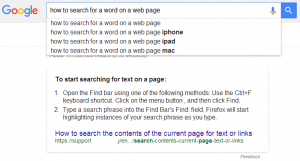Share this Post
Year 2015 brought some substantial changes into SEO strategies, as 2016 is fast approaching, every one is asking about top SEO tactics. From our research lab, recent SEO seminars and discussions with top SEO gurus around the world we selected top ten Search Engine Optimisation trends in 2016, which are
1- Why responsive web design is must for getting top ranking in Google?
these are the questions we are often asked in the web design business.
According to Wikipedia:
“Responsive web design (RWD) is an approach to web design aimed at crafting sites to provide an optimal viewing and interaction experience, easy reading and navigation with a minimum of resizing, panning, and scrolling, across a wide range of devices (from desktop computer monitors to mobile phones and tablets)”.
When you look around at the incredible changes in the device market these days you can clearly see how the internet market is evolving. The current market research shows upto 70% increase in the mobile use, which means if your business information is not mobile friendly you are not reaching your target customers.
2- Higher Google page ranking doesn’t mean more clicks
We are all trying to reach page one or above the fold but time has shown us different results at different times, now higher ranking and on page one doesn’t mean more traffic due to Paid ads, quality display ads, mobile display ads, local deal and packs, carousel results, knowledge graphs, reviews and rich snippets, all these attention-grabbing SERP elements can drain away the clicks from your number 1 ranking website.
3- Page speed
We all know that even patient people can’t stand waiting in lines, no matter that’s at the bank waiting for salary, call centres, airport, or pizza shop. We either get bored or angry that it’s taking longer than expected, Many times we’ll let it slide to get better design, new nifty functionality or to add more content to web pages. Unfortunately, website visitors tend to care more about speed than all unnecessary tricks that we want to add to our websites, so what we should learn from this in business is that if your result page is not coming up quickly then your users will go some where else.
Google has also introduced mobile and pagespeed tools which helps you Analyse your site performance and identify ways to make your site faster and mobile friendly.
4- Keywords are changed
The terms that customers type into search engines and your internal search function can represent a wealth of valuable data.
This data can help you to gain an understanding of user behaviour and can be used to improve site search and more. Recent studies and Google search console has shown big change in keywords identification, Google’s Hummingbird update introduced semantic searching, changes our strategy on Search Engine Optimisation from researching exact keywords to research of related terms and synonyms.
One area that direct answers definitely comes into play is with voice and mobile searching. People want quick answers when they have a question. This is one of the reasons Google has spent so much time developing direct answers, so people could quickly speak a question and receive an answer quickly. For tools like Siri and Cortona to be functional, this concept is fundamental.
5- Quality and rich answers
Another huge tendency in search is the increase of Google’s rich answers.
A “Rich Answer” is any attempt by Google to answer the searcher’s query in search results in a way not requiring a click through to a website.
6- User experience
Google increasingly considers user behaviour signals. Factors like page load time, button size on a mobile screen and ad cluttering above the fold, all speak to the weight of user experience signals in the organic search algorithm.
7- More complexity in google analytics
Google Analytics is recording all clicks your website getting from different visitors but when Google Analytics is unable to identify where your site’s visits are coming from, the visits are recorded as direct traffic and with time these un-identifiable visits keep growing in numbers, your Google Analytics reports get less precise, they report a direct traffic growth while in reality it should grow your organic, social and mobile traffic.
How to be aware of the cases when your traffic goes direct.
the common cases are:
1- Traffic from a Https site to Http.
2- Traffic from image and other media search
3- Traffic from applications
4- A big portion of traffic from social media like Facebook, Twitter, You tube, SnapChat, WhatsApp.
8- Link penalties are removable and important
Its very important to take link penalties serious and protect your site from getting penalize, You need to actively disavow and remove low quality links that you find during link audits even if you don’t have a penalty yet.
9- Local businesses are given preference in search result
Local SEO is given preference as Google has gotten better at location detection on both desktop and mobile results, clearly the location of a business matters immensely, but only relative to where people are physically conducting their searches.
According to google my business support page Ranking of local results on Google, “Google Maps search results are based primarily on relevance, distance, and prominence. These factors are combined to help us find the best match for your search. For example, our search technology might decide that a business that’s farther away from your location is more likely to have what you’re looking for than a business that’s closer. Here’s more detail on what relevance, distance, and prominence mean:
Relevance: Relevance is how well a local listing matches what someone is searching for. Adding complete and detailed business information can help us better understand your business and match you to relevant search results.
Distance: Just like it sounds — how far is each potential search result from the location term used in a search? If you don’t specify a location in your search, we’ll calculate distance based on what we know about your location.
Prominence: This describes how well-known or prominent a business can be. This is based on information we have about a business from across the web (like links, articles, and directories). Some places are more prominent in the offline world, and we try to reflect this online as well. For example, famous museums, landmark hotels, or well-known store brands that are familiar to many people are also likely to be more prominent in search results”.
Local businesses or large scale companies with local departments or shops should put schema tagging and local listings as a top priority to capture a local market which will be receiving increasingly relevant results in 2016.
10-Link building in 2016
Link building is not dead, it just reached a new level of complexity and is now more advanced than ever before. Google search is all about relevancy and authority therefore building links in niche websites and directories showing relevant information is beneficial for you. Paid link building is long gone even if you are guest posting you should be careful and do proper research about your industry other wise even white hat links can black list your site.
The future of link building is all about content, instead of spending time and money on spamy link its better to share valuable research and information with your industry and customers and add value to your brand.
The author’s views are entirely his or her own and may not reflect the views of CodifyMedia.
Share this Post



